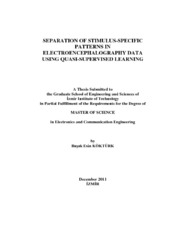Please use this identifier to cite or link to this item:
https://hdl.handle.net/11147/3158Full metadata record
| DC Field | Value | Language |
|---|---|---|
| dc.contributor.advisor | Karaçalı, Bilge | - |
| dc.contributor.author | Köktürk, Başak Esin | - |
| dc.date.accessioned | 2014-07-22T13:51:00Z | - |
| dc.date.available | 2014-07-22T13:51:00Z | - |
| dc.date.issued | 2011 | - |
| dc.identifier.uri | http://hdl.handle.net/11147/3158 | - |
| dc.description | Thesis (Master)--Izmir Institute of Technology, Electronics and Communication Engineering, Izmir, 2011 | en_US |
| dc.description | Includes bibliographical references (leaves: 78-80) | en_US |
| dc.description | Text in English; Abstract: Turkish and English | en_US |
| dc.description | xii, 80 leaves | en_US |
| dc.description.abstract | In this study separation of the electroencephalography data recorded under different visual stimuli is investigated using the quasi-supervised learning algorithm. The quasi-supervised learning algorithm estimates the posterior probabilities associated with the different stimuli, thus identifying the EEG data samples that are exclusively specific to their respective stimuli directly and automatically from the data. The data used in this study contains 32 channels EEG recording under six different visual stimuli in random successive order. In our study, we have first constructed EEG profiles to represent instantaneous brain activity from the EEG data by various combinations of independent component analysis and the wavelet transform following data preprocessing. Then, we have applied the binary and M-ary quasi-supervised learning to identify condition-specific EEG profiles in different comparison scenarios. The results reveal that the quasi-supervised learning algorithm is successful in capturing the distinction between the samples. In addition, feature extraction using independent component analysis increased the performance of the quasi-supervised learning and the wavelet decomposition revealed the different frequency bands of the features, making more explicit the separation of the samples. The best results we obtained by combining the wavelet decomposition and the independent component analysis before the quasisupervised learning algorithm. | en_US |
| dc.language.iso | en | en_US |
| dc.publisher | Izmir Institute of Technology | en_US |
| dc.rights | info:eu-repo/semantics/openAccess | en_US |
| dc.subject.lcsh | Supervised learning (Machine learning) | en |
| dc.subject.lcsh | Electroencephalography | en |
| dc.subject.lcsh | Independent component analysis | en |
| dc.subject.lcsh | Wavelets (Mathematics) | en |
| dc.title | Separation of Stimulus-Specific Patterns in Electroencephalography Data Using Quasi-Supervised Learning | en_US |
| dc.type | Master Thesis | en_US |
| dc.institutionauthor | Köktürk, Başak Esin | - |
| dc.department | Thesis (Master)--İzmir Institute of Technology, Electrical and Electronics Engineering | en_US |
| dc.relation.publicationcategory | Tez | en_US |
| dc.identifier.wosquality | N/A | - |
| dc.identifier.scopusquality | N/A | - |
| item.openairecristype | http://purl.org/coar/resource_type/c_18cf | - |
| item.languageiso639-1 | en | - |
| item.openairetype | Master Thesis | - |
| item.grantfulltext | open | - |
| item.fulltext | With Fulltext | - |
| item.cerifentitytype | Publications | - |
| Appears in Collections: | Master Degree / Yüksek Lisans Tezleri | |
Files in This Item:
| File | Description | Size | Format | |
|---|---|---|---|---|
| T000971.pdf | MasterThesis | 4.86 MB | Adobe PDF |  View/Open |
CORE Recommender
Page view(s)
152
checked on Mar 31, 2025
Download(s)
90
checked on Mar 31, 2025
Google ScholarTM
Check
Items in GCRIS Repository are protected by copyright, with all rights reserved, unless otherwise indicated.